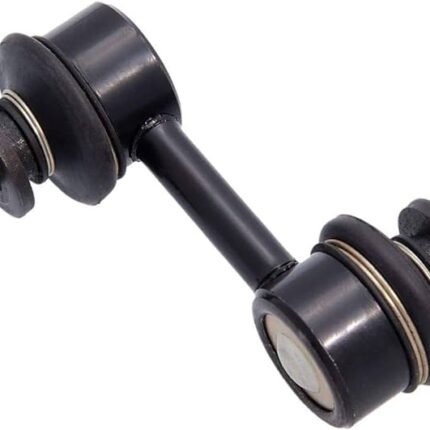Get Subaru S12 / G13 / B14 Front Stabilizer Link Assy
The stabilizer link assembly, also known as a sway bar link or anti-roll bar link, is a critical component in a vehicle’s suspension system. It connects the stabilizer bar (sway bar) to the suspension components, such as the control arms or struts, helping to improve vehicle stability and handling by reducing body roll during cornering. Here’s a detailed look at the stabilizer link assembly, its functions, signs of wear, and maintenance aspects:
Functions of Stabilizer Link Assembly
- Reducing Body Roll
Primary Function: Minimize the amount of body roll experienced during cornering and sharp maneuvers.
Details:
- Force Distribution: The stabilizer bar distributes the lateral forces from one side of the suspension to the other. The links connect this bar to the suspension, ensuring these forces are effectively transferred.
- Improved Stability: This connection helps keep the vehicle’s body level during turns, enhancing stability and reducing the risk of rollovers.
- Enhancing Handling
Primary Function: Improve the vehicle’s handling characteristics and responsiveness.
Details:
- Better Traction: By keeping the vehicle more level, the stabilizer links help maintain better tire contact with the road, improving traction.
- Controlled Movement: They limit the amount of sway or roll the vehicle experiences, leading to more predictable and controlled handling.
- Connecting Suspension Components
Primary Function: Serve as a crucial connection between the stabilizer bar and the suspension parts, ensuring they work together effectively.
Details:
- Rigid Linkage: The links provide a firm connection that allows the stabilizer bar to perform its function efficiently.
- Flexibility: They allow for some movement to accommodate the vertical motion of the suspension while ensuring the stabilizer bar can counteract body roll.
- Maintaining Suspension Geometry
Primary Function: Help maintain the proper alignment and geometry of the suspension system.
Details:
- Consistent Handling: Properly functioning stabilizer links help maintain the suspension alignment, contributing to consistent handling characteristics.
- Prevention of Excessive Movement: They prevent excessive movement of the suspension components, which could lead to misalignment and uneven tire wear.
Signs of Worn or Failing Stabilizer Link Assembly
- Unusual Noises
Description: Clunking, rattling, or knocking noises, especially when driving over bumps or uneven surfaces.
Details:
- Loose Links: Worn or damaged stabilizer links can become loose, causing metal-to-metal contact and resulting in these noises.
- Damaged Bushings: The bushings or joints in the stabilizer links can wear out, leading to increased play and noise.
- Poor Handling and Increased Body Roll
Description: Noticeable increase in body roll during cornering and overall reduced handling performance.
Details:
- Reduced Effectiveness: Worn stabilizer links can’t effectively transfer forces, leading to increased body roll and reduced stability.
- Handling Issues: The vehicle may feel less responsive or stable during turns.
- Uneven Tire Wear
Description: Abnormal or uneven wear patterns on tires.
Details:
- Alignment Problems: Failing stabilizer links can cause misalignment of suspension components, leading to uneven tire wear.
- Steering Instability
Description: The vehicle feels unstable or wanders, especially at higher speeds or during turns.
Details:
- Loose Connections: Worn links can cause the suspension to be less connected, leading to instability and steering issues.
- Visual Inspection Issues
Description: Visible signs of wear or damage upon inspection.
Details:
- Cracked Bushings: Bushings may be cracked, worn, or missing.
- Corrosion or Damage: The links themselves may show signs of corrosion, bending, or other physical damage.
Maintenance and Replacement
- Regular Inspection: Periodically inspect the stabilizer links for signs of wear, damage, or looseness. Look for cracked or worn bushings, broken links, or excessive movement.
- Lubrication: Some stabilizer links have lubrication points that should be maintained to prevent wear and reduce noise. Modern sealed units generally do not require lubrication.
- Replacement:
- Tools and Safety: Replacing stabilizer links typically involves lifting the vehicle, removing the old links, and installing new ones. This can require specific tools and safety precautions.
- Professional Help: If unsure, it’s advisable to have a professional mechanic perform the replacement to ensure it’s done correctly.
Follow us on Facebook for more parts.




